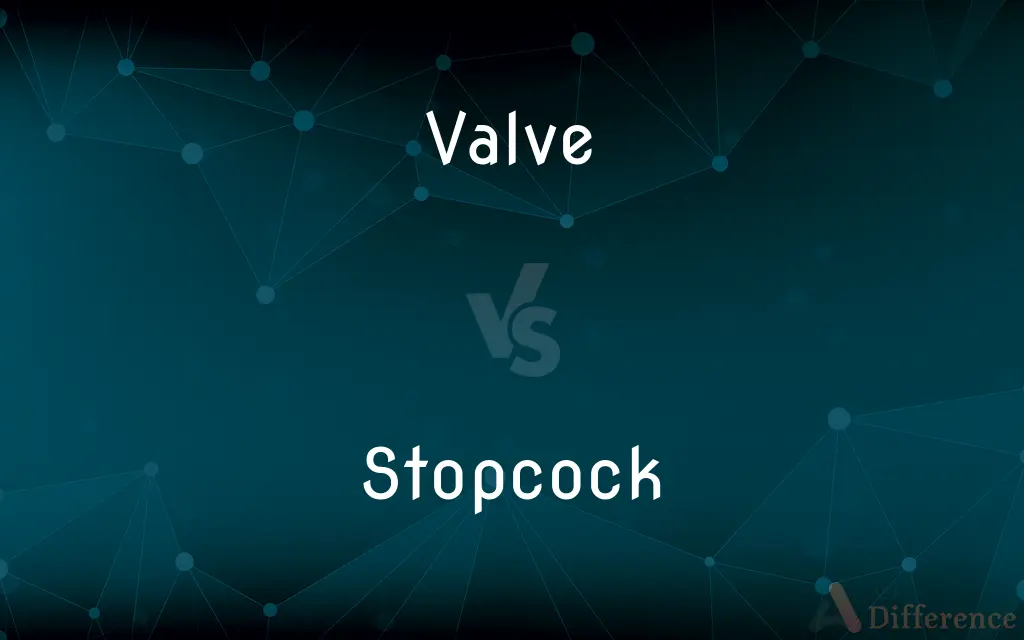Valve vs. Stopcock — What's the Difference?
Edited by Tayyaba Rehman — By Fiza Rafique — Updated on November 3, 2023
A valve is a device regulating the flow of fluids, while a stopcock is a specific type of valve for controlling liquid flow via a spigot.

Difference Between Valve and Stopcock
Table of Contents
ADVERTISEMENT
Key Differences
Valves are mechanical devices that control the flow and pressure within a system. Stopcocks are a particular type of valve that regulate the flow of liquid or gas and are often used in laboratory settings.
The design of a valve varies widely depending on its purpose; they can be found in everything from car engines to medical devices. Stopcocks have a simpler design, typically operated by a turn knob that controls the flow in small conduits.
Valves are integral to the operation of vast systems like oil pipelines or water treatment plants. Stopcocks are used where precise control of liquid or gas is required, like in burettes or gas taps in a lab.
Maintenance for valves depends on their use and can be complex, involving electronic or pneumatic control systems. Stopcocks are generally low maintenance, needing only occasional greasing or cleaning to ensure a good seal.
In industries, valves are critical for safety and efficiency, often part of larger automated systems. Stopcocks are used for hands-on applications, where manual control is necessary for safety and precision.
ADVERTISEMENT
Comparison Chart
General Definition
A device for controlling flow.
A valve type with a spout for controlling flow.
Operation
Can be automatic or manual.
Typically manual via a turn knob.
Usage Complexity
Ranges from simple to complex.
Generally simple and precise.
Application Scope
Broad, from industrial to household.
Often used in laboratories and plumbing.
Maintenance and Control
Can require technical maintenance.
Usually requires basic maintenance.
Compare with Definitions
Valve
Part of a musical instrument that changes the pitch.
He carefully cleaned the trumpet's valves.
Stopcock
A tap or small faucet for controlling flow.
Turn the stopcock to release water into the system.
Valve
A device that controls the flow of a fluid.
They installed a new valve in the water line.
Stopcock
Used to control the flow in a burette.
Make sure the stopcock is closed before filling the burette.
Valve
A biological structure that regulates the flow of fluids.
The heart's valves prevent blood from flowing backward.
Stopcock
A laboratory device for controlling the flow of liquids.
She carefully adjusted the stopcock to get the right amount of reagent.
Valve
A valve is a device or natural object that regulates, directs or controls the flow of a fluid (gases, liquids, fluidized solids, or slurries) by opening, closing, or partially obstructing various passageways. Valves are technically fittings, but are usually discussed as a separate category.
Stopcock
A stopcock is a form of valve used to control the flow of a liquid or gas. The term is not precise and is applied to many different types of valve.
Valve
A device for controlling the passage of fluid or air through a pipe, duct, etc., especially an automatic device allowing movement in one direction only
A valve shuts off the flow from the boiler when the water is hot enough
Stopcock
A plumbing fitting for isolating a section of pipe.
We had to shut off the stopcock to fix the leak.
Valve
Each of the halves of the hinged shell of a bivalve mollusc or brachiopod, or of the parts of the compound shell of a barnacle.
Stopcock
A valve with a spout that can be turned to regulate flow.
The stopcock needs to be greased to turn smoothly.
Valve
Any of various devices that regulate the flow of gases, liquids, or loose materials through piping or through apertures by opening, closing, or obstructing ports or passageways.
Stopcock
An externally operated valve regulating the flow of a liquid or gas through a pipe, in particular one on the water main supplying a house
In many houses, the main stopcock is situated under the kitchen sink
Valve
The movable control element of such a device.
Stopcock
A valve that regulates the flow of fluid through a pipe; a faucet.
Valve
A device in a brass wind instrument that can be opened or closed to change the pitch by altering the length of the air column in the tube.
Stopcock
A valve, tap or faucet which regulates the flow of liquid or gas through a pipe.
Valve
(Anatomy) A membranous structure in a hollow organ or passage, as in an artery or vein, that folds or closes to prevent the return flow of the body fluid passing through it.
Stopcock
(British) A main shutoff#Noun for water to a home from a municipal supply. Usually these valves exist in pairs, one outside the property boundary and one inside the property boundary.
If you have a burst pipe, turn the water off at the stopcock.
Valve
A piece of shell covering or enclosing certain mollusks or other invertebrates, especially the single one of a univalve mollusk or one of the paired hinged ones of a bivalve mollusk or brachiopod.
Stopcock
(transitive) To control the gas pressure in (an oil well) by keeping the well closed in and the gas confined except during set intervals when the oil is flowed or pumped.
Valve
One of the two siliceous halves of the cell wall of a diatom.
Stopcock
A bib, faucet, or short pipe, fitted with a turning stopper or plug for permitting or restraining the flow of a liquid or gas; a cock or valve for checking or regulating the flow of water, gas, etc., through or from a pipe, etc.
Valve
One of the pieces into which a plant part splits at maturity, especially a segment of a fruit capsule or of certain anthers.
Stopcock
The turning plug, stopper, or spigot of a faucet.
Valve
Chiefly British An electron tube or a vacuum tube.
Stopcock
Faucet consisting of a rotating device for regulating flow of a liquid
Valve
(Archaic) Either half of a double or folding door.
Valve
To provide with a valve.
Valve
To control by means of a valve.
Valve
A device that controls the flow of a gas or fluid through a pipe.
Shut off the valve
Open the valve
Valve
A device that admits fuel and air into the cylinder of an internal combustion engine, or one that allows combustion gases to exit.
Valve
(anatomy) One or more membranous partitions, flaps, or folds, which permit the passage of the contents of a vessel or cavity in one direction, but stop or control the flow in the opposite direction
The ileocolic, mitral, and semilunar valves
Valve
One of the leaves of a folding-door, or a window-sash.
Valve
(British) A vacuum tube.
Valve
(botany) One of the pieces into which certain fruits naturally separate when they dehisce.
Valve
(botany) A small portion of certain anthers, which opens like a trapdoor to allow the pollen to escape, such as in the barberry.
Valve
(biology) One of the pieces or divisions of bivalve or multivalve shells.
Valve
(biology) One of the two similar portions of the shell of a diatom.
Valve
(transitive) To control (flow) by means of a valve.
Valve
A door; especially, one of a pair of folding doors, or one of the leaves of such a door.
Swift through the valves the visionary fairRepassed.
Heavily closed, . . . the valves of the barn doors.
Valve
A lid, plug, or cover, applied to an aperture so that by its movement, as by swinging, lifting and falling, sliding, turning, or the like, it will open or close the aperture to permit or prevent passage, as of a fluid.
Valve
One or more membranous partitions, flaps, or folds, which permit the passage of the contents of a vessel or cavity in one direction, but stop or retard the flow in the opposite direction; as, the ileocolic, mitral, and semilunar valves.
Valve
One of the pieces into which a capsule naturally separates when it bursts.
Valve
One of the pieces or divisions of bivalve or multivalve shells.
Valve
A structure in a hollow organ (like the heart) with a flap to insure one-way flow of fluid through it
Valve
Device in a brass wind instrument for varying the length of the air column to alter the pitch of a tone
Valve
Control consisting of a mechanical device for controlling the flow of a fluid
Valve
An apparatus that controls the flow of air.
The technician adjusted the air valve to reduce noise.
Valve
A mechanism in engines that opens and closes passages.
The mechanic said the engine's valves needed replacing.
Common Curiosities
Can a stopcock be considered a valve?
Yes, a stopcock is a specific type of valve.
What is a valve used for?
A valve controls the flow and pressure within a system.
Are valves only found in industrial settings?
No, valves are used in a wide range of settings, including household applications.
Do stopcocks require a power source to operate?
Typically, no. Stopcocks are usually operated manually.
What kind of maintenance do valves need?
It varies widely from simple lubrication to complex calibration and part replacement.
Can a stopcock be used in a high-pressure system?
It depends on its design, but stopcocks are generally used for low to moderate pressure applications.
What materials are valves made from?
Valves can be made from plastic, metal, ceramic, and other materials depending on the application.
Is specialized training required to operate a valve?
For complex valve systems, yes. For basic valves, no special training is needed.
What is a stopcock used for?
A stopcock regulates the flow of liquid or gas through a spigot.
Are stopcocks used in home plumbing?
Yes, they can be used as shut-off valves in residential plumbing.
Can valves regulate gas flow?
Yes, valves are designed to regulate both liquid and gas flows.
Are all valves manually operated?
No, some valves are automatic and can be controlled electronically or pneumatically.
How does one maintain a stopcock?
Regular cleaning and greasing are usually sufficient.
Are stopcocks used for any gases?
Yes, they can be used for gas flow, especially in laboratories.
What materials are stopcocks made from?
Stopcocks are commonly made from brass, glass, or plastic.
Share Your Discovery

Previous Comparison
Enochlophobia vs. Ochlophobia
Next Comparison
Audacity vs. TemerityAuthor Spotlight
Written by
Fiza RafiqueFiza Rafique is a skilled content writer at AskDifference.com, where she meticulously refines and enhances written pieces. Drawing from her vast editorial expertise, Fiza ensures clarity, accuracy, and precision in every article. Passionate about language, she continually seeks to elevate the quality of content for readers worldwide.
Edited by
Tayyaba RehmanTayyaba Rehman is a distinguished writer, currently serving as a primary contributor to askdifference.com. As a researcher in semantics and etymology, Tayyaba's passion for the complexity of languages and their distinctions has found a perfect home on the platform. Tayyaba delves into the intricacies of language, distinguishing between commonly confused words and phrases, thereby providing clarity for readers worldwide.















































